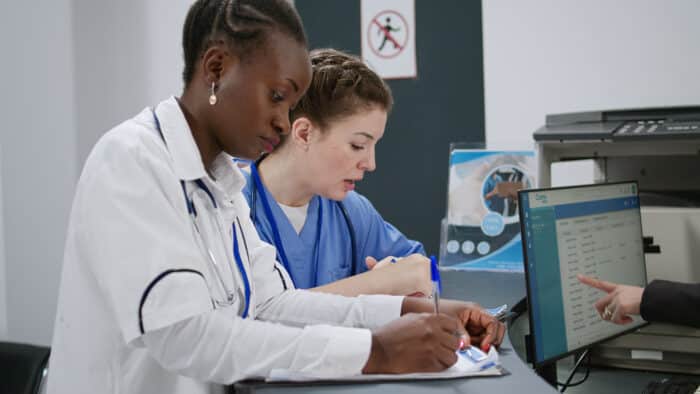Have you ever stopped to think about what a typical day looks like for a medical coder?
Do they spend all their time just coding, or is there more to it?
And if you’re thinking about jumping into the world of medical coding, is it really worth it?
If these questions have crossed your mind, you’re not alone.
In this article, we’re going to dig into all of that and more. We’ll break down what medical coders actually do, whether it’s a good career choice, and what opportunities might be waiting for you in this field.
So, let’s dive right in and get some answers!
What Does a Day in the Life of a Medical Coder Look Like?
If you’re interested in becoming a Medical Coder, you might be curious about what a day in the life of one looks like, before you fully step into the career.
We’re here to help you with that.
Let us break a Medical Coder’s typical day into hours and see what a work day looks like:
6:00 AM – 7:00 AM: Morning Preparation
You begin your day by getting ready for work. You review your schedule, noting any meetings or deadlines you have for the day ahead. You may also take this time to catch up on industry news or review any coding updates or changes that have been released overnight.
7:00 AM – 8:00 AM: Arrival and Review
You arrive at work and settle into your workspace. You start by reviewing any pending tasks from the previous day and prioritize your workload for today. This may involve checking your inbox for any urgent messages or tasks that require immediate attention.
8:00 AM – 10:00 AM: Coding Sessions
With your priorities set, you dive into coding sessions. You review medical records, interpret physicians’ notes, and extract relevant information to assign accurate diagnostic and procedural codes. This process requires careful attention to detail and adherence to coding guidelines and regulations.
10:00 AM – 11:00 AM: Collaboration and Communication
As mid-morning approaches, you take a break from coding to communicate with healthcare providers and other members of the coding team. You may participate in coding roundtable discussions, clarify documentation with physicians, or address any coding-related queries from colleagues.
11:00 AM – 12:00 PM: Problem-Solving and Analysis
As the morning progresses, you encounter complex medical cases that require deeper analysis. You research unfamiliar medical terminology, consult coding resources, and collaborate with colleagues to resolve coding discrepancies or clarify documentation issues.
1:00 PM – 3:00 PM: Adaptation to Changes
After lunch, you return to your desk and resume coding tasks. You stay alert for any updates or changes in healthcare regulations or coding guidelines that may impact your work. You adapt your coding practices accordingly, ensuring compliance with the latest requirements to maintain accurate reporting and reimbursement.
3:00 PM – 4:00 PM: Quality Assurance
As the afternoon progresses, you shift your focus to quality assurance activities. You conduct audits of coded medical records, verifying accuracy and identifying areas for improvement. You may also participate in peer reviews or coding education sessions to enhance coding accuracy and consistency across the team.
4:00 PM – 5:00 PM: Documentation and Reflection
As the end of the day approaches, you wrap up your coding tasks and documentation. You finalize any remaining coding assignments, ensuring that all records are accurately coded and documented for auditing and reporting purposes. You take a moment to reflect on the day’s accomplishments and challenges, noting any lessons learned or areas for improvement.
5:00 PM: End of Day
With the workday coming to a close, you tidy up your workspace and prepare to head home. You may review your schedule for tomorrow and make any necessary notes or reminders to ensure a smooth start to the next day.
See: What is Medical Billing and Coding?
Career Scope of Medical Coding
Now that you’ve got a peek into what a day in the life of a Medical Coder is like, you might be wondering about the bigger picture of this career path.
Let’s dig into it.
When it comes to how much medical coders make, according to the U.S. Bureau of Labor Statistics, the average salary is around $48,780.
But here’s the thing – these numbers can vary a lot. Factors like where you work, how much experience you have, and any certifications you might hold can all play a role in what you earn.
Now, let’s talk about job prospects. The job outlook looks good. The Bureau of Labor Statistics says that between 2021 and 2031, the number of phlebotomy jobs is expected to grow by 8%. That’s faster than the average for most other jobs out there.
Career Paths You Can Discover as a Medical Coder
If you’re coming here as an experienced medical coder looking to switch fields without letting your experience go to waste,
or if you’re just simply interested in this career and want to know the alternate paths you can choose after you become a medical coder, you’re in the right place.
Here is a list of alternate career paths that you can choose as a Medical Coder:
Medical Coding Specialist:
– The foundation of your career, where you assign codes to medical procedures, diagnoses, and services.
– Opportunities to specialize in different coding systems like ICD-10-CM, CPT, and HCPCS.
Certified Professional Coder (CPC):
– Attaining certification through organizations like AAPC can lead to higher-paying positions and increased job opportunities.
– Recognition for your expertise in medical coding, making you a sought-after professional in the field.
Coding Auditor:
– Responsible for reviewing coded medical records to ensure accuracy and compliance with coding guidelines.
– Conducts audits to identify coding errors and discrepancies, contributing to billing accuracy and regulatory compliance.
Coding Supervisor/Manager:
– Leadership role overseeing a team of medical coders.
– Responsibilities include training, assigning coding tasks, and ensuring productivity and quality standards are met.
Consultant/Independent Contractor:
– Offers coding expertise and consulting services to healthcare organizations.
– Assists with coding audits, compliance reviews, and process improvement initiatives.
Specialty Coder:
– Opportunities to specialize in specific areas of healthcare like oncology, cardiology, or orthopedics.
– Requires in-depth knowledge of specialty-specific coding guidelines and procedures.
Medical Billing Specialist:
– Transition into the billing side of healthcare, where you process and submit claims to insurance companies.
– Requires understanding of medical coding and insurance reimbursement processes.
Healthcare Compliance Officer:
– Ensures healthcare organizations comply with coding and billing regulations.
– Conducts audits, develops compliance policies, and provides training on regulatory requirements.
Electronic Health Records (EHR) Specialist:
– Works with EHR systems to ensure accurate and efficient documentation of patient information.
– Collaborates with healthcare providers to optimize EHR workflows and data integrity.
Healthcare Data Analyst:
– Analyzes healthcare data to identify trends, patterns, and opportunities for improvement.
– Utilizes coding data to inform decision-making and improve patient outcomes.
Read: Best 4-Week Online Medical Coding and Billing Course
Conclusion
In short, medical coders are crucial for accurate healthcare records and billing. They sort through records, assign codes, and ensure everything follows the rules. Despite challenges, their work helps keep healthcare efficient and trustworthy for everyone involved.
Related Resources:
Related Articles
-
How to Be Successful in College in 2022 – 7 Simple Tips to Succeed
-
How Do Scholarships Work? Read This First…Truth is Shocking
-
7 Best College Majors 2024: What Should I Major In?
-
How to Choose a College – 10 Things You Must Consider in 2024
-
Why Go to College? Top 13 Benefits for Adult Students in 2022
-
Top 5 Best Alternatives to Community College for 2024








